|
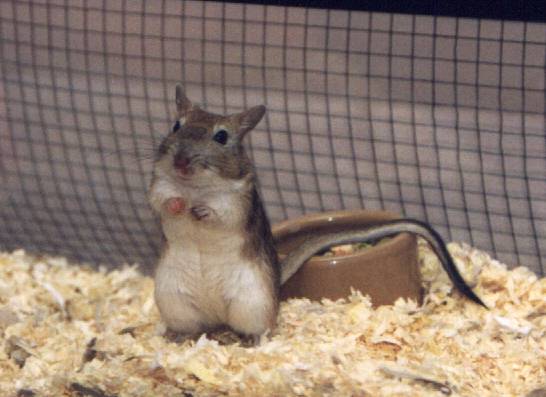


First appeared in the NGS Journal, December 1995.
CONTENTS
WHAT THEY ARE
The Shaw's Jird (Meriones shawi) is about the same size as a rat and looks
like a giant version of the Mongolian Gerbil. Indeed, the two species are
closely related. They both belong to the same branch of the gerbil family, The
Jirds. The Mongolian Gerbil is in fact not a true gerbil at all but a jird. Its
proper name is the Clawed Jird (Meriones unguiculatus).
The Shaw's Jird originates from the arid areas of North Africa and the Middle
East. It has been used extensively in research laboratories but has only been
kept as a pet relatively recently. Up to about 10 years ago, a similar species,
the Libyan Jird, was kept as a pet but the Shaw's Jird
has been found to be friendlier and to make the better pet.
![[Picture]](images/thumb32.jpg) ![[Picture]](images/thumb33.jpg)
Click on these thumbnails to view the larger originals.
Shaw's Jirds make wonderful pets. They have the same innate friendliness and
natural curiosity as their Mongolian cousins. They rarely bite and enjoy being
handled. Being that much bigger, they are easier to cuddle. They are also
extremely intelligent. I let mine out for a run around my flat and have no
trouble recapturing them. I just call them and they come to me and let me pick
them up. I have also trained them to go to the toilet on a piece of newspaper
placed on the floor for this purpose. The only problem with giving them the
freedom of the room is that being rodents they will gnaw at everything. Shaw's
Jird have bigger teeth than Mongolian Gerbils and are able to cause more damage.
It is important to make sure that all electric cables are beyond their reach. In
my case, the telephone was a perennial problem. After being cut off the phone
three times by probing gnashers, I had to get BT to come and move the plug so it
was four feet up the wall. Shaw's Jird seem particularly partial to ripping up
wallpaper and pulling chunks out of the carpet. Pet jirds should be kept as a
pair in the case of males or singly in the case of females. (See the section on
breeding below for an explanation of this).
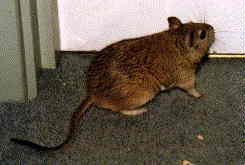
Photo by
The Shaw's housing requirements are similar to the Mongolian's. I find that a
30" aquarium provides adequate accommodation for a pair. As with my
Mongolian Gerbils, I make permanent tunnels at the bottom of the tanks with clay
pipes, large jars and other ceramic containers, and I cover this with a deep
layer of wood chips. Whilst female Shaw's invariably make use of the pipes for
their sleeping quarters, males often choose to remain on the surface whilst they
sleep. This may be because the males prefer to sleep stretched out on their
backs with all four paws in the air!. This is just one of the differences
between male and female which contributes to problems with compatibility. (See
the section on Breeding below for more on this).
Like Mongolian Gerbils, the basic diet of the Shaw's Jird is a mixture of
seeds and grains. However, they are more omnivorous and relish variety. Unlike
Mongolians they enjoy all types of fruit and vegetables. They also need a small
amount of meat. Some breeders give them tinned cat food. I give mine mealworms
twice a week as I find this less messy.
![[Picture]](images/thumb47.jpg)
![[Picture]](images/thumb46.jpg)
![[Picture]](images/thumb48.jpg)
If you just want to keep Shaw's Jird as pets and do not wish to breed from
them, then you should choose either two males or a SINGLE female. A pair of
males will live happily together and as with Mongolian Gerbils appear to become
very attached to their partners. Females, on the other hand, are much more
aggressive towards other jirds. (They are fine with people). If they have been
introduced at an early age, two females may live together amicably for a while
but they are likely to start to fight as they get older. Unfortunately, the same
is true of a mixed sex pair and this makes breeding Shaw's Jird very difficult.
Female Shaw's are dominant. They are very territorial and will monopolise the
bed, bedding and food. No matter how much food and bedding is put into the cage,
the female will take it all mouthful by mouthful and store it in her bedroom.
Should the male be foolish enough to try and enter this sacred domain or to
impede the female in any way, the female will grab his tail in her mouth and
pull hard. If she grabs the tip of the tail, then she may pull it off. More
likely she will inflict a nasty bite. As the harassment continues, both male and
female will begin to show signs of stress. Their noses may bleed and a
blood-coloured discharge may come from their eyes. Both will develop scabs from
bites on their tails and feet. As soon as the lid is taken off the cage, the
male may try to run away. Unlike incompatible Mongolian Gerbils, I have never
known Shaw's Jird to engage in mortal combat. Nevertheless, there usually comes
a point when for the health of both they have to be separated. How then is it
possible to breed from Shaw's Jird? Most of the ones I have bred have been from
young females. Females mature early and if they are paired with an older male
are likely to mate when they are around ten weeks old. One or possibly two
litters may be successfully raised before the pair have to be separated. With
older females living alone, it is a case of putting the male in her cage for an
hour or so when she is on heat. This is quite easy to detect. If the male is
held close to the female's cage so the pair can smell one another, the female
will wag her tail vigorously if she is on heat. If she is not on heat, then she
will squeak loudly and attempt to attack the male. The gestation period for
Shaw's Jird would appear to be similar to Mongolian Gerbils, 24-26 days.
However, young Shaw's develop faster. By the time they are 16 days old their
eyes are wide open, they are fully mobile and they are eating solid food
voraciously (unlike Mongolians who are only taking their first tentative nibbles
at this stage). From this time on they grow incredibly quickly. However, their
mother continues to keep a watchful eye on them and it is not uncommon to see
her struggling to pick them up in her mouth and return them to the nest until
they are about four weeks old. Like Mongolians, Female Shaw's come on heat a few
hours after giving birth. If a successful mating takes place, then a new litter
will be born when the previous one is only just over three weeks old. Though
this is not desirable, Mongolian Gerbils seem to be able to cope with this and
successfully rear the new litter. Shaw's Jird, don't and any litter born as a
result of a breed back in this way is likely to be neglected and die.
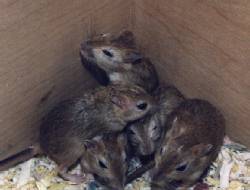
Young Shaw's Jirds
Information about Shaw's Jird is extremely difficult to find. I have only
come across the odd paragraph about them in books on gerbils and other rodents.
However, if you are seriously thinking about acquiring a breeding pair then you
might like to take note of the following:
"The world's greatest mammalian lover is Shaw's Jird of North Africa,
which is frequently used as an experimental laboratory animal. One 60g male was
observed to mate 224 times in 2 hours!" (Wood, G L The Guinness book
of animal facts and feats 3rd edition Guinness Superlatives. 1982)
There is a good site devoted to Shaw's
Jirds.

By Julian Barker
First Appeared in the NGS Journal, March 2001
After the Mongolian Gerbil (Meriones unguiculatus,) the species of gerbil
normally kept as a pet, Shaw's Jird (M. shawi) is easily the next most common
species of gerbil seen in British pet shops - so common is this gerbil that in
Britain the word 'jird' is synonymous with Shaw's Jird, despite the increasing
popularity of other jirds. Despite its popularity as a pet, I have found very
little written about how these gerbils live in the wild.
The Shaw's Jird is a large gerbil. Males can easily grow to 350mm (14 inches)
or more in length. The tail is usually half the overall length. Shaw's Jirds
look very much like a large Mongolian Gerbil. The main differences, other than
size, are the usually darker colouring, (although lighter coloured Shaw's Jirds
are known,) a less prominent tuft at the tip of the tail, and larger ears which
are much less hairy than those of Mongolian Gerbils.
There are at least two sub-species of Shaw's Jird, and Shaw's Jirds are
similar enough to two other North African species, the Libyan Jird (M libycus)
and Sundervall's Jird (M. crassus) to have caused decades of confusion amongst
taxonomists. For many years Shaw's Jirds were thought to be no more than a
sub-species of the Libyan Jird, but genetic an breeding studies have shown that
they are different, if closely related species. The Shaw's Jirds we have in the
UK share characteristics that normally differ between Shaw's Jirds and Libyan
Jirds. This may indicate that they are in fact hybrids.
Shaw's Jirds come from the coastal regions of North Africa. They are known
from Morocco, Algeria, Libya and Egypt. They prefer either sandy areas near to
date palms or clay soils near areas of cultivated barley. They dig extensive
burrow systems with many entrances. They are mainly nocturnal, although
occasionally seen on the surface during the day. They are know to be predated
upon by owls.
Shaw's Jirds do no appear to have a specific breeding season even in the
wild. Sexually active males have been observed in March, July and November.
Depending on the climate their numbers can suddenly increase and can become a
menace to agriculture.
In captivity it is easy to keep Shaw's Jirds. They are easy to handle and
make excellent pets. Apart from needing more space, they can be kept more or
less the same way as Mongolian Gerbils. Shaw's Jirds are less communal than
Mongolian Gerbils, so they may sometimes be less willing to share a tank with
other jirds. As shown in the picture illustrating this article, many
domesticated animals have white spots on the head, and sometimes on the tip of
the tail.
It has been noted that Shaw's Jirds kept in mainland Europe are different to
those that have been present in the UK since at least the 1980's. British
animals tend to be larger, have thicker tails, and broader facial features. The
two types do interbreed and it may be that UK Shaw's Jirds have undergone
hybridization with Libyan Jirds, or it may be that UK Shaw's jirds are derived
from a different region from the European variety, and may therefore be derived
from a different sub-species.
References:
A REVISION OF THE GENUS MERIONES.: Chaworth-Musters, J.L. and Ellermann,
J.R., 1948, Proceedings of the general meetings for scientific Zoological
Society, 1243, 478-504
RANDOM X-CHROMOSOME INACTIVATION IN INTERSPECIFIC HYBRIDS OF MERIONES LIBYCUS
(M) X MERIONES SHAWI (F) (RODENTIA: GERBILLINAE).: Cohen, M.M., Hastings, C.,
Nadler, C.F., Lay, D.M., 1971, Experienta, 27/9, 1084-6
MAMMALS OF ALGERIA, Kowalski, K. Rzebik-Kowalska, B, Zaklad Narodowy Imienia
Ossolinskich Wydawnictwo Polskiej Akademii Nauk Wroclaw, Poland., 1991, 219-53
HYBRIDIZATION IN THE RODENT GENUS MERIONES I. BREEDING AND CYTOLOGICAL
ANALYSIS OF MERIONES SHAWI x MERIONES LIBYCUS HYBRIDS: Lay, D.M., Nadler, C.F.,
1969, Cytogenetics, 8, 35-50
THE CONTEMPORARY LAND ANIMALS OF EGYPT (INCLUDING SINAI). (Fieldiana Zoology,
no. 5), Osborn, D.J. & Helmy, I, 1980, 94-245
RECHERCHE DŽUN INDICE CRANIOMETRIQUE DISCRIMINANT DEUX ESPECES DE MERIONES
(MERIONES SHAWI ET M. LIBYCUS) VIVANT EN SYMPATRIE SUR LE SITE DE GUELMINE
(MAROC): Zaime, A.K., and M. Pascal, 1988, Mammalia, 52, 575-582

There seems to be a lot of differences between the animals that are called
Shaw's Jirds in the UK. It may be that in fact these jirds are the result of
breeding together various sub-species of Shaw's Jird, or even the result of
hybridisation with Libyan Jirds (Meriones libycus).
There appears to be the following visible features:
| |
Type |
Size |
Colour |
Face |
Ears |
Tail |
![[Picture]](images/thumb32.jpg) |
Southern |
Larger |
Darker Greyer |
Long |
Dark |
Dark |
![[Picture]](images/thumb68.jpg) |
Libyan Hybrid? |
Larger |
Lighter Oranger |
Slightly Longish |
Lighter |
Dark Tip Only |
![[Picture]](images/thumb69.jpg) |
Dutch |
Smaller |
Darker Greyer |
Shorter - Rounded Snout |
Dark |
Dark |
![[Picture]](images/thumb66.jpg) |
German |
Smaller |
Darker Greyer |
Short - Pointed |
Dark |
Dark |
NB, the names are only my shorthand based on either their origin or the place
where I have seen them. So for example, it doesn't mean that all Jirds in
Southern England are "Southern Type" or that all animals in Germany
are the "German Type". Also, please note that the colours in the
pictures is very dependant on the lighting conditions under which they were
taken.
Not only do Shaw's Jirds vary in appearance, they also vary in temperament.
German and Dutch jirds (that I have seen in the UK) seem to be much more
timid and more difficult to handle than the other types. You can see this by the
hunched appearance of these two types in the photos above.
There are several known subspecies of Meriones shawi and it is known that
even in the same sub-species, there can be significant differences in colouring.
This is true for almost all mammalian species. See - DESERT COLOURATION IN
RODENTS: David L Harrision, Chapter XIII, pages 269-276 of RODENTS IN DESERT
ENVIRONMENTS, Prakash, L and Gosh, P.K. (volume editors), Dr W. Junk b.v.
Publishers, The Hague., 1975, 90 6193 080 4
This hand coloured print by J Smith and published in Proceedings of the
Zoological Society in 1884 shows an animal looking very like the German/Dutch
type of jird, rather then the type more common in the UK.
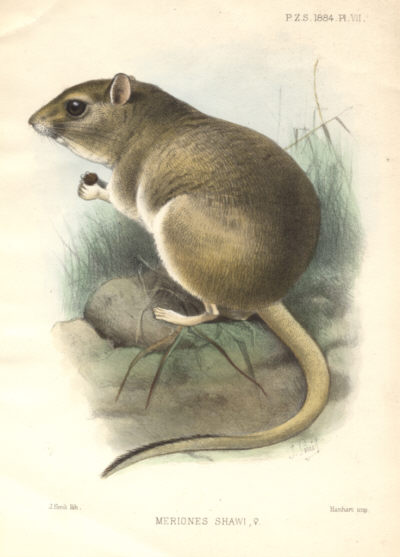

For many years now Shaw's Jirds in the UK have often exhibited a
small white spot on the forehead. More recently, a spot on the neck and a
white tip to the tail have started to appear in some Jirds.
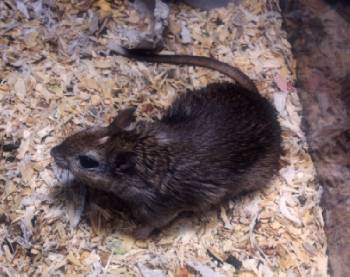
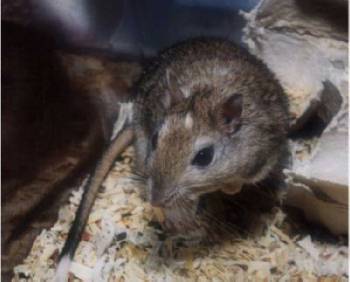
In addition, the colour of Shaw's Jirds varies a lot in
intensity. They can vary from orange to very dark with a lot of grey. But all
these animals are clearly Agouti. This variation is likely to be due to
modifying genes and not a major mutation.
For more information on the coat colour genetics of gerbils
visit my genetics page.

![[Picture]](images/shaw.jpg)
![[Picture]](images/shaw1.jpg)
Finally, for some more info - visit the Gerbil-Info
pages.

                          
Return to the NGS Homepage?
The views presented on this page are not necessarily those of the National
Gerbil Society.
Please note that the material on these webpages is covered by copyright law.
If you wish to use any pictures etc for anything other than your personal
private use, such as publishing material on a website, then
This web page may include links to other web sites. These links are provided
in order to enhance the interest and usefulness of other content and are not
intended to signify that the National Gerbil Society, or the authors of material
featured on the NGS Website, endorses or otherwise has any responsibility for
the content of any linked web page, web site or other linked material.
This page has been constructed by
Telephone number for media contact only - (+44)
07941893143

Last updated 14 September 2009 | 

![[Picture]](images/thumb32.jpg)
![[Picture]](images/thumb33.jpg)

![[Picture]](images/thumb47.jpg)
![[Picture]](images/thumb46.jpg)
![[Picture]](images/thumb48.jpg)

![[Picture]](images/thumb68.jpg)
![[Picture]](images/thumb69.jpg)
![[Picture]](images/thumb66.jpg)



![[Picture]](images/shaw.jpg)
![[Picture]](images/shaw1.jpg)